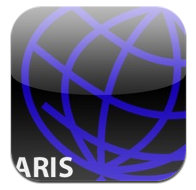I’d stumbled upon ARIS about a year ago but never had a chance to try it out until recently. Given that I’m now doing workshops on geolocation stuff and I’m presenting at an Enhancing Fieldwork showcase, it seemed the right moment to try.
ARIS is a free tool for creating location based “games” that can be accessed and played via an iPhone app. It’s similar in many ways to HP’s Mediascapes that I did some stuff with back in Sheffield a few years ago. It’s been designed by a team based at the University of Wisconsin-Madison.
Using a Flash based editor on your desktop you add “objects” to a Google Map and then set the behaviours for each of them. Objects can be:
- Items – virtual objects that can be picked up and stored in the iphone app’s inventory, or carried and dropped by players
- Plaques – information and media (audio and video) pop-ups, perhaps telling you about a location or giving you new instructions
- Characters – essentially virtual people that you can programme with branching converstaions for a player to interact with.
Each of these items can include “requirements” so that they behave in a particular way. For example a character won’t appear on the map for a player to talk to until then have picked up a certain item.
Objects and the tasks and behaviours surrounding them can then be grouped into “quests”. So, to complete a quest a player has to find a certain number of items, talk to various characters or visit locations etc; there then might be a follow-up quest to complete, and so on.
When the player is out in the field using the GPS-enabled app, they access the game on the server (you need internet connectivity) and away they go. As they get within a defined proximity of an object, the phone will vibrate and give off a (pretty loud) tone. They then view the plaque, pickup the item or interact with the character. The player can see a map of their location and the game can be played blind or the designer can choose to reveal the location of some or all objects.
Another neat touch is that the app allows the player to take pictures or record audio within the game. In the mock-up I did I had a “Will Allen” avatar pop up while I was outside Haymarket Metro instructing me to take a picture of a particular statue. Once I’d done that, the avatar popped up again to confirm I’d done what he asked. Neat.
You can find much more detailed info on their site and get started here.
Some random initial thoughts:
- There’s obvious applications for enhancing fieldwork, either from the point of view of giving students added information about the locations they are visiting or going to the other extreme of highly interactive stotytelling activities like the Dow Day “participative documentary” example on the ARIS website.
- The ability to easily create dynamic objects is a step forward from the clunky (but pioneering) Mediascape.
- I designed my game to have a mix of objects that were viewable on my iPhone’s map all the time along with others that were hidden or appeared after completing a task. Having a completely invisible game is likely to lead to confusion. At least consider having a starting location marked.
- It’s just about simple enough for more able school students (and I guess most FE and HE students) to be able to create their own content. You don’t need any web development skills.
- I think I prefer this sort of approach to other AR apps like Layar or Junaio. They’re difficult to create stuff for and cost to publish.
- The iPhone is a much more reliable and enjoyable device for this than those nasty EDA things we used to use for Mediascape!
- Having said that, the GPS isn’t pinpoint accurate so I had to include a fairly large margin of error (30-40m) on the placing of the objects. Having the game in a built-up environment also created problems for the GPS accuracy. Not insurmountable, but I think these games are likely to work better wheer they range over a wide area.
- Having the iPhone as the only device that can run it is a real barrier. They suggest a possible solution for mifi and GPS-enabling iPod Touches but I’ve no idea how well these things work. An Android option would also be good but a web app would be even better.
- I encountered a few server errors and app crashes when testing mine. I was still able to complete my “quest” but it was enough to make me feel jumpy about running this sort of activity with large numbers of students.
- Planning and testing are really important to ensure functionality but also comprehensibility. Do game players understand what they have to achiveve and how to go about doing it? It could easily get frustrating for players without clear directions.
For all it’s problems, it’s still really good.There’s lost more stuff I’d like to try with ARIS but for reasons of time I’ll have leave it there for now.
Leave a comment if you’ve had any experience with it.

One reply on “Making location-based activities with ARIS”
Awesome! The game editor can download a KML showing all the media created by players of the game for display in Google Earth. Shows who created the media and when. Great for building collaborative stories about places!Not so awesome: Forget your player password? Need to create another account from scratch – not difficult but could be a real headache if trying to manage a large group of students on a field trip.It’s also possible to run ARIS off your own server. As it says: "ARIS is built in PHP 4 and MySQL 4. Any xAMP server should run it just fine." It’s opensource and available on an MIT GNU license.